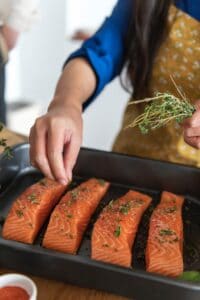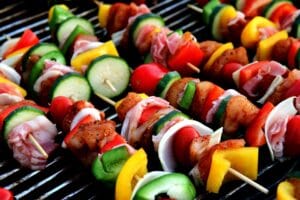Summer is here and for a lot of people that means shorts, tanks, sandals and grilling. As we switch from indoor cooking to outdoor cooking keep in mind health and safety. Practice the following tips to ensure a safe and healthy meal:

5 Tips for Safe and Healthy Grilled Food
-
-
- Get you and your grill ready for use. Dress in non-loose fitting clothes and have water available to keep yourself hydrated. Place your grill outside in a well ventilated area and have access to water to spray down flames if needed.
- Start with a clean grill and clean hands. If touching food directly, you will need to take a break to wash your hands after food is put on the grill. Remember to put your grill away clean too!
- Pick a good menu.
-
-
-
-
-
- For the Protein: Pick lean “healthy” meats. When I say healthy I mean avoid the processed foods such as hot dogs and brats and pick a healthier lean protein such as chicken, pork or fish. I suggested lean meats because research has shown that when grilling protein we can cause the carcinogens heterocyclic amine (HCA) and polycyclic aromatic hydrocarbons (PAHs) to form. To avoid this, we generally want to cook at lower temps and avoid charring our meat, picking leaner meats will avoid excess fat dripping to cause the flames that create this (there are some grills out there that avoid this by not using flames). If you are afraid of the meat being too dry, use a healthy marinade to help provide good flavor and extra moisture.
- Thaw frozen meat in the refrigerator or microwave prior to cooking.
- Use a digital temperature to make sure your meat is done! Ground meats-160F, Chicken-165F, Fish-145F. follow this link for a more complete guide:
- For the Protein: Pick lean “healthy” meats. When I say healthy I mean avoid the processed foods such as hot dogs and brats and pick a healthier lean protein such as chicken, pork or fish. I suggested lean meats because research has shown that when grilling protein we can cause the carcinogens heterocyclic amine (HCA) and polycyclic aromatic hydrocarbons (PAHs) to form. To avoid this, we generally want to cook at lower temps and avoid charring our meat, picking leaner meats will avoid excess fat dripping to cause the flames that create this (there are some grills out there that avoid this by not using flames). If you are afraid of the meat being too dry, use a healthy marinade to help provide good flavor and extra moisture.
-
-
-
https://www.health.state.mn.us/people/foodsafety/cook/cooktemp.pdf
-
-
-
-
- Don’t forget your fruits and vegetables! Being sure to fill at least half your plate with fruits and vegetables is a health must. You can have these fresh, steamed or why not grilled?! We can grill these in several ways from grill baskets to grill pans to foil to skewers. We generally want them in something so they are not falling into the grill but some items may be okay directly on the grill (such as long cuts of asparagus)! Lightly toss with oil and a seasoning and pick which grilling option you have room for. I enjoy mixing some fruit with my vegetables to create new flavors such as grilled pineapple with peppers, potatoes and broccoli on skewers is one of my favorites.

- If salads are on your menu such as potato salad or other salads that should be kept cold, keep them in the refrigerator until serving time and put them back in the refrigerator afterwards or create a cold serving area by putting ice in a pan and putting your salads in a bowl in it to keep it cold.
- Don’t forget your fruits and vegetables! Being sure to fill at least half your plate with fruits and vegetables is a health must. You can have these fresh, steamed or why not grilled?! We can grill these in several ways from grill baskets to grill pans to foil to skewers. We generally want them in something so they are not falling into the grill but some items may be okay directly on the grill (such as long cuts of asparagus)! Lightly toss with oil and a seasoning and pick which grilling option you have room for. I enjoy mixing some fruit with my vegetables to create new flavors such as grilled pineapple with peppers, potatoes and broccoli on skewers is one of my favorites.
-
- Don’t cross contaminate. This means using separate plates and serving utensils for raw food and cooked food. Once I put on the raw food, I instantly bring in the raw plates and utensils (you can also wash these), wash my hands and grab clean plates and utensils for the cooked food. I like a clean cooking space and don’t want those raw juices going on any of my cooked food which could make me, my family or friends sick.
- Cover food and keep it warm. Cover your food after it is cooked to help keep it warm as well as to prevent insects from attacking. If you are not going to be eating your food immediately, keep it extra warm by putting it in a crockpot, roaster or oven on low.
-
-
-
Blog Written By: Betsy Plotz, Registered Dietitian
